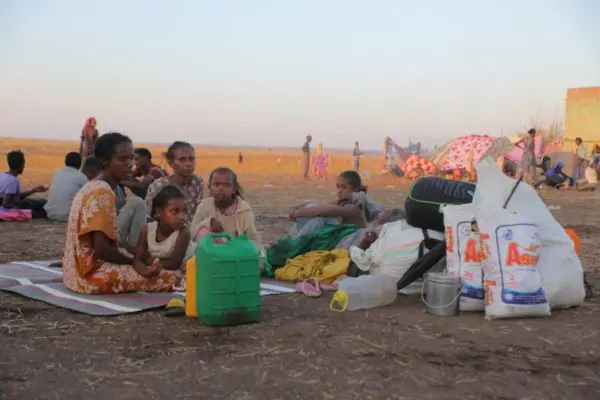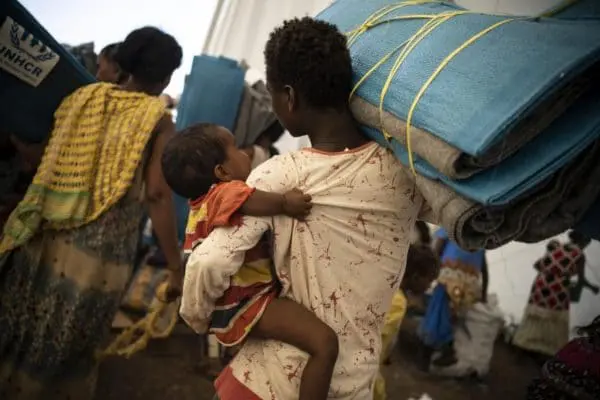
The first group of refugees from Ethiopia’s Tigray region are welcomed by UNHCR staff at the Tunaydbah refugee camp, Sudan. © UNHCR
This is a summary of what was said by UNHCR spokesperson Andrej Mahecic – to whom quoted text may be attributed – at today’s press briefing at the Palais des Nations in Geneva.
UNHCR, the UN Refugee Agency, continues to register new refugee arrivals at the Sudanese-Ethiopian border. Some 800 people crossed from Ethiopia’s Tigray region into eastern Sudan in just the first few days of the new year. Since early November, more than 56,000 Ethiopian refugees have fled to neighbouring Sudan.
Latest arrivals tell of being caught in the conflict and being victims of various armed groups, facing perilous situations including looting of their houses, forceful recruitment of men and boys, sexual violence against women and girls. Refugees are arriving with little more than the clothes on their backs, fatigued and in weak conditions after sometimes days of travel. More than 30 per cent of them are estimated to be under 18 and 5 per cent over 60 years old.
In support of the government-led response in Sudan, UNHCR and Sudan’s Commission for Refugees (COR) continue to relocate the refugees from the arrival locations at the border to the designated refugee camps, further inland in Sudan’s Gedaref State.
With the Um Rakuba refugee camp approaching its full capacity, UNHCR and its partners are striving to swiftly relocate refugees from reception sites at the border to a second, newly opened refugee camp, Tunaydbah, in order to keep refugees safe and offer them better living conditions.
The new site is located some 136 kilometres from Gedaref town. Since this Sunday, 580 refugees were relocated to Tunaydbah from Village 8 reception site, with relocations from Hamdayet reception site set to start also this week. Both reception sites are overcrowded, and their close location to the border putting the safety and security of refugees increasingly at risk.
Upon arrival to Tunaydbah, hot meals are being provided and 1,000 tents, aimed at sheltering up to 5,000 people, have so far been set up by partners. More tents are being pitched as the relocation is set to progress in the coming days and weeks.
UNHCR, COR, and partners are scaling up their response to meet the needs of the increasing refugee population in all locations. Currently, more than 20 humanitarian partners are on the ground in Um Rakuba and another six are starting their activities in Tunaydbah to assist and engage the refugee and host community with shelter, health, food and nutrition services.
Once more, the government of Sudan is generously keeping its border open to refugees, but additional support is needed to complement the authorities’ response. In particular, it is critical to further improve water and sanitation conditions in the refugee camps and reception areas, as well as to ramp up COVID-19 prevention measures, including isolation facilities. Additional funding is also required to sustain shelter projects and improve the living conditions of refugees in the camps, especially in anticipation of the next rainy season expected to start in May.
As at the end of 2020, US$40 million has been pledged to UNHCR for the regional response to the emergency in Ethiopia’s Tigray region, which covers only 37 per cent of the financial requirements in Sudan, Ethiopia, and Djibouti.
For more information on this topic, please contact:
- In Khartoum, Giulia Raffaelli, raffaelg@unhcr.org, +249 (0) 912 167 016
- In Nairobi, Dana Hughes, hughes@unhcr.org, +254 733 440 536
- In Addis Ababa, Juliette Stevenson, stevenso@unhcr.org, +251 944 109 031
- In Geneva, Andrej Mahecic, mahecic@unhcr.org, +41 7964 29709
- In New York, Kathryn Mahoney, mahoney@unhcr.org, +1 347 443 7646
Originally published by UNHCR on 5 January 2021.





